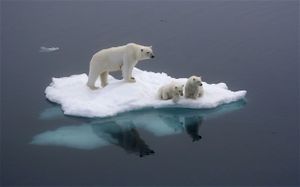Habitat range change

Climate change, both natural or anthropogenic, has a major implication on ecosystems. This includes changing where species (both plant and animal) can live. Due to rising temperatures, changes in land use for agriculture, deforestation and other changes to the environment, many species are forced to adapt to the new climate by changing their habitat and migration patterns.[2]
Cause for Habitat Change
There are many reasons as to why a specific species may have to change and adapt to a new habitat. Global warming, drought, floods, deforestation and land use changes are amongst the leading factors. Different species require different temperatures and altitudes to survive. For example with land species, rising temperatures cause species that favour cooler climates to begin move north. In areas where temperatures are cooling, species that prefer warmer temperatures need to adapt to a different climate as well. This can have implications depending on the species as this new range and can remove vital predators or prey that are crucial to maintaining the food chain in that area. Similarly with aquatic species, as sea levels rise, freshwater and salt water systems may start mixing thus relocating many organisms.[3]
North American Species Habitat Changes
In North America, many animals are already showing signs of habitat range change. Some of which include the polar bear, the pika, waterfowl and many other avian species.[4][2]
- After spending time in the south, many bird species have been returning north up to two weeks earlier than their normal migratory cycles. Many bird species are also suffering from their loss of habitat from either drought or floods causing them to shift habitats completely. Most species of butterfly are being observed changing their migration timing and also arriving earlier.
- The polar bear in the Hudson Bay area have always survived by living on Arctic sea ice. However with rising temperatures they are slowing starting to starve as sea ice rapidly melts. Polar bears are now forced to begin hunting for their food earlier in the spring and later in the fall resulting in less time to prepare for hibernation.
- The North American pika is a hamster sized mammal that lives on or near mountain peaks particularly in the west. As temperatures rise, they are beginning to move to higher elevations to fit their cool temperature needs.
The Nature Conservancy has an animated map showing the future of species migration.[5]

For Further Reading
For further information please see the related pages below:
- Deforestation
- Drought
- Flood
- Glacier
- Climate change
- Or explore a random page
References
- ↑ WCRP. Melting Ice and Global Consequences. Available: http://wcrp-climate.org/grand-challenges/gc-melting-ice-global-consequences
- ↑ 2.0 2.1 EPA. Ecosystems – Climate Impact on Ecosystems [Online]. Available: https://www3.epa.gov/climatechange/impacts/ecosystems.html
- ↑ I.-C. Chen, J. K. Hill, R. Ohlemuller, D. B. Roy, and C. D. Thomas, “Rapid Range Shifts of Species Associated with High Levels of Climate Warming,” Science, vol. 333, no. 6045, pp. 1024–1026, Aug. 2011.
- ↑ Root, T. L. & Schneider, S. H. in Wildlife Responses to Climate Change: North American Case Studies (eds Schneider, S. H. & Root, T. L.) 1–56 (Island Press, Washington DC, 2002).
- ↑ Lawler, JJ, et al. 2013. Projected climate-driven faunal movement routes. Ecology Letters 16(8): 1014-1022. McGuire, JL, et al. 2016. Achieving climate connectivity in a fragmented landscape. Proceedings of the National Academy of Sciences: 113: 7195-7200. Available:http://maps.tnc.org/migrations-in-motion/#4/44.09/-113.16

